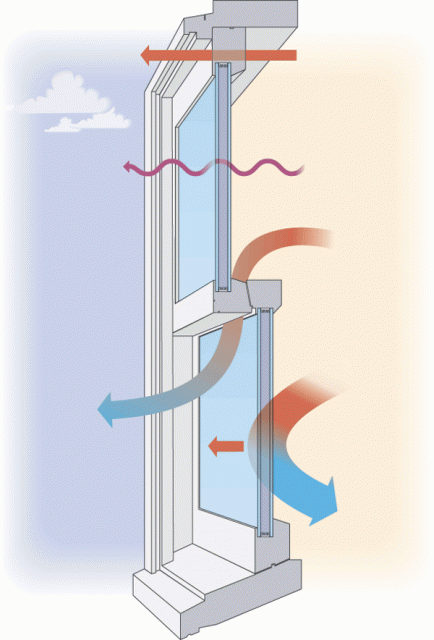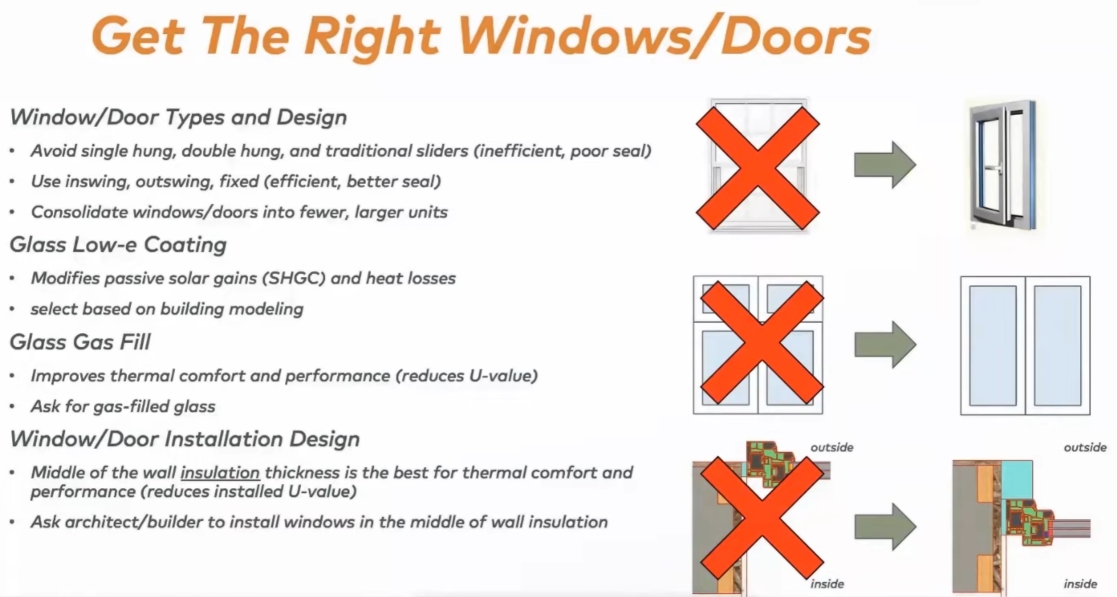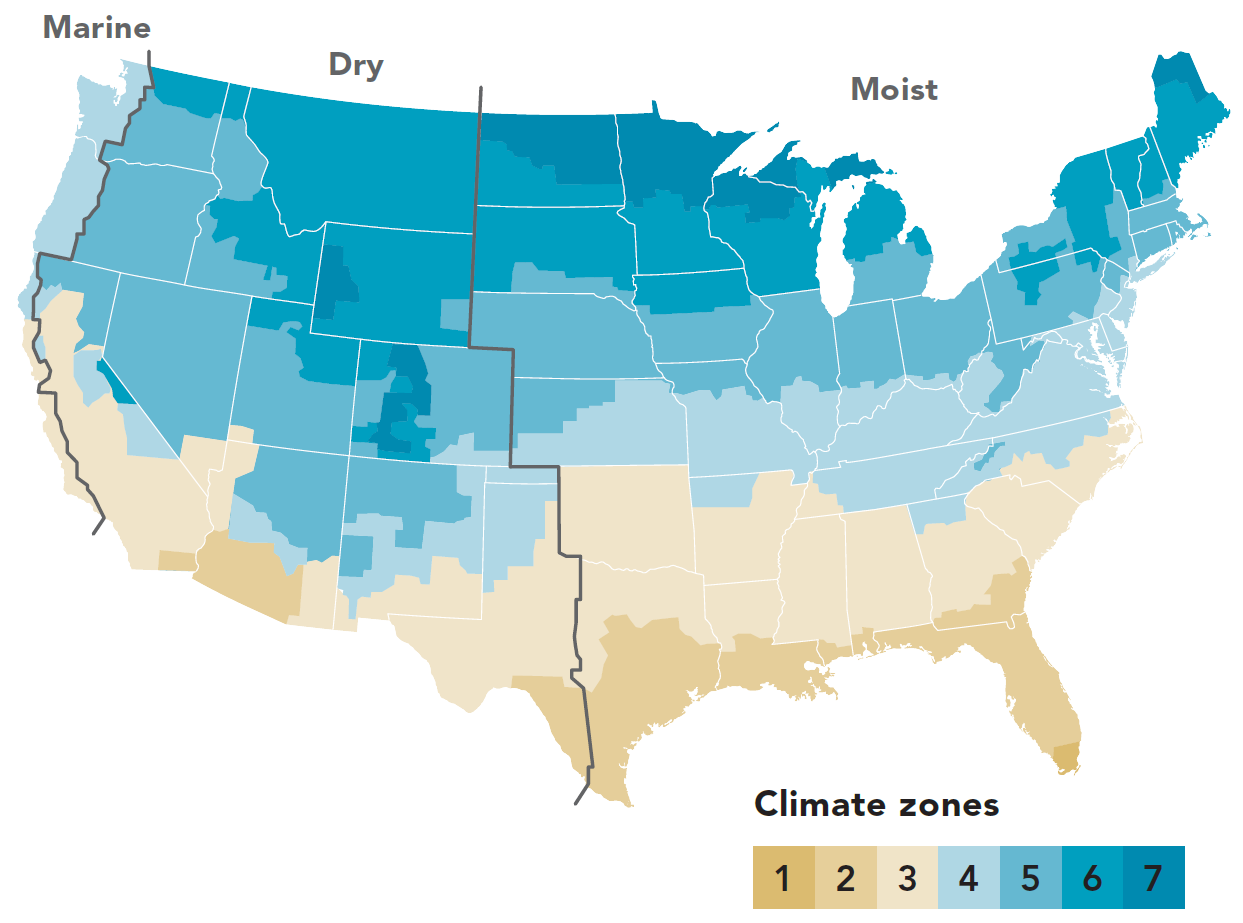Windows

Windows are among the most complex building components in a house, and at several hundred dollars or more apiece, also among the most expensive. In addition to the important architectural contribution they make, windows have far-reaching energy consequences. Their number, total area, and orientation to the sun can make or break the energy efficiency of a high-performance home.
Ratings
There is no one-size-fits-all standard for choosing the glass, or glazing, in windows. The most appropriate glass for a house in the Southwest won't be the best choice for a house in Maine. Glass on a home's north side should have different characteristics than south-facing glass. Tuning glass for specific applications is an important part of passive solar design.
The National Fenestration Rating Council (NFRC) rates windows on three criteria: U-factor, SHGC, and visual transmittance (VT). Look for the NFRC label on rated windows (www.nfrc.org).
U-factor measures how much heat is transmitted through the glass. The U-factor is the inverse of R-value. The lower the U-factor, the more efficiently the glass blocks the passage of heat. In all climates, windows with a low U-factor perform better than windows with a high U-factor. The EPA's Energy Star guidelines vary by region. In northern climates, an Energy Star–rated window must have a maximum U-factor of 0.35, the equivalent of an R-2.8 insulated wall.
Solar heat gain coefficient (SHGC) is the fraction of solar radiation admitted through a window, expressed as a number between 0 and 1. Lower numbers mean less of the sun's heat is transmitted through the glass. The lower the SHGC, the greater the shading ability of the glazing. In climate Zone 1-3, 0.25 is required. In Climate zone 4 and greater, 0.45 is required.
Visual transmittance (VT) is the fraction of visible light energy that makes it through the window glass. The higher the fraction, the more visible light will reach into the room. Maximizing VT while getting the right combination of U-factor and SHGC, particularly with low-e coatings, can be challenging. All three properties must be considered and balanced to evaluate window performance.
NFRC ratings for U-factor and SHGC are whole-window ratings, not glass-only ratings.
Types

Window frames do more than hold the glass in place and allow the window to open and close. They are an important part of a window's overall thermal performance, and the type of frame helps dictate how much maintenance the window will need over its lifetime. Frame materials include wood, fiberglass, vinyl, aluminum, and both vinyl- and aluminum-clad substrates.
Fiberglass and aluminum are likely to be the most durable choices. From an energy perspective, fiberglass is far preferable to aluminum. Aluminum windows are highly conductive; since they don't insulate as well as vinyl, wood, or fiberglass frames, they are rarely appropriate for an energy-efficient house. (Remember, just because a window has aluminum cladding doesn't mean that the window has aluminum frames. In most cases, aluminum-clad windows are made of wood.) Foam-filled fiberglass frames perform better than other materials. Foam-filled vinyl frames are a close second, followed by wood frames. Some manufacturers offer composite frames made from a variety of materials; if these include a thermal break, they can perform well.
Casements are better than sliders. Windows are available in a variety of styles, including double-hung, single-hung, horizontal sliders, and casements. Casement windows should be the first choice for an energy-efficient home. Because the cam lock on a casement window pulls the sash tightly against the weatherstripping, a well-built casement will have less air leakage than the best available double-hung window.
Glazing
As the thermal performance of the frame and glazing improves, the performance of the spacer (with thermal effects that can extend out up to more than 2 inches into the glazing) becomes more important. And spacer performance is important in controlling condensation as well. Look to all three elements of a window for high performance.
Single glazing is a very poor insulator, with an R-value of about 1 (equivalent to U-1). Increasing the number of panes in a window improves the insulating value of the window, so clear double glazing has an R-value of about 2 (equivalent to U-0.5), and clear triple glazing has an R-value of about 3 (equivalent to U-0.33). The values for double or triple glazing can be further improved by including one or two low-e coatings and an inert gas fill between the panes. The best double-glazed windows have a whole-window U-factor of about 0.27, while the best triple-glazed windows have a whole-window U-factor of about 0.17.
Except for Hawaii, windows installed in any U.S. state should always have at least double glazing. Triple glazing costs significantly more and only makes sense for colder climates unless a house is facing a very noisy location and needs acoustic isolation, you have the money to put towards them, or you are shooting for a passive house. In addition to saving energy and reducing noise transmission, triple-glazed windows increase comfort by raising the temperature of a room's coldest surfaces in winter. When windows are warmer, the body radiates less heat toward them and feels more comfortable.
A low-e coating is a thin, nearly invisible metallic coating on glass that lowers the emissivity of the glass. The effect of the coating is to lower a window's U-factor, improving its performance as a thermal insulator. There are at least two major categories of low-e coatings: soft-coat low-e (also known as vacuum-deposition or sputtered low-e) and hard-coat low-e (also known as pyrolytic low-e). Within each category, different formulations are possible. Spectrally selective low-e coatings are formulated to achieve a low SHGC. A low-e window designed for the south wall of a passive solar house should have a low U-factor coupled with a high SHGC.
Dealing with the Sun
Designers of passive solar homes need to specify orientation-specific glazing. In a colder or less mild climate, south-facing windows need high-solar-gain glazing, while west-facing windows need low-solar-gain glazing. The SHGC of north windows doesn't matter much. When it comes to east windows, climate determines which type of glazing makes sense. In regions of North America where air conditioning is rarely used, high-solar-gain glazing is probably a good choice for east windows, since solar heat is welcome on cool mornings.
In warmer regions, east windows, which like west windows are hard to shade, should probably have low-solar-gain glazing. Protect south-facing windows with a roof overhang designed to shade them in summer while allowing the winter sun to enter the house. In warmer areas, choosing glazing with an extremely low SHGC — especially for east and west windows — will significantly lower air-conditioning loads. Look for windows with SHGCs that are significantly lower than the Energy Star standard of 0.40.
Chapter 11 of the IRC sets the baseline for energy efficiency in building envelopes — but if you're considering passive solar heating, you'll probably have to do better than code. Directly using the sun's heat usually means plenty of south windows. If glass covers more than 15% of your exterior walls, you'll need to meet the stricter insulation requirements prescribed by the IECC. Even though the IECC sets the bar a bit higher, a passive solar home has some unique needs that might encourage you to up your R-values by as much as 40% or 50%. In warmer climates in the south, a window-to-wall ratio up to 30% is do-able.
Windows don't work when the sun isn't shining. The IECC tries to compensate for all that extra glass with higher R-values in the rest of the building envelope. But even if you super-insulate your walls and ceilings, the best windows will still be the weak link when it comes to heat loss. I'm a bit timid on passive solar heating in most colder climates because the winter skies are usually much cloudier, making their purpose moot for most of the winter.
Manufacturers
Canadian manufacturers are more likely to offer triple glazing than their American counterparts, but more and more U.S. window manufacturers are joining in:
- Alpen Windows
- Alside
- Comfort Line
- Great Lakes Windows
- Marvin Windows
- Paramount Windows
- Schuco USA
- Vinyl Kraft
- Weather Shield
